Peroxymonosulfate Activation by Bi-Fe Oxide Co-Doped Graphitic Carbon Nitride for Degradation of Sulfamethoxazole: Performance and Mechanism
Abstract
:1. Introduction
2. Materials and Methods
2.1. Materials and Chemicals
2.2. Bi@Fe/CN Preparation Method
2.3. Characterization
2.4. Degradation Experiments and Analytical Methods
3. Results and Discussion
3.1. Characterization of Bi@Fe/CN
3.2. Catalytic Degradation of SMX
3.3. Influence of the Co-Existing Ions
3.4. Stability and Recyclability of Bi@Fe/CN-3
3.5. Catalytic Mechanism
4. Conclusions
Supplementary Materials
Author Contributions
Funding
Institutional Review Board Statement
Informed Consent Statement
Data Availability Statement
Conflicts of Interest
Abbreviations
References
- Dutta, S.; Mandal, W.; Desai, A.V.; Fajal, S.; Dam, G.K.; Mukherjee, S.; Ghosh, S.K. A luminescent cationic MOF and its polymer composite membrane elicit selective sensing of antibiotics and pesticides in water. Mol. Syst. Des. Eng. 2023, 8, 1483–1491. [Google Scholar] [CrossRef]
- Yu, C.; Huang, H.; Jin, H.; Zhang, W.; Lv, Z.; Zhao, L. Contamination by antibiotics and their degradation and removal methods. Mar. Freshw. Res. 2023, 74, 766–769. [Google Scholar] [CrossRef]
- Mandal, W.; Fajal, S.; Samanta, P.; Dutta, S.; Shirolkar, M.M.; More, Y.D.; Ghosh, S.K. Selective and sensitive recognition of specific types of toxic organic pollutants with a chemically stable highly Luminescent Porous Organic Polymer (POP). ACS Appl. Polym. Mater. 2022, 4, 8633–8644. [Google Scholar] [CrossRef]
- Yang, W.; Li, J.; Yao, Z.; Li, M. A review on the alternatives to antibiotics and the treatment of antibiotic pollution: Current development and future prospects. Sci. Total Environ. 2024, 926, 171757. [Google Scholar] [CrossRef] [PubMed]
- Yan, J.; Li, J.; Peng, J.; Zhang, H.; Zhang, Y.; Lai, B. Efficient degradation of sulfamethoxazole by the CuO@Al2O3 (EPC) coupled PMS system: Optimization, degradation pathways and toxicity evaluation. Chem. Eng. J. 2019, 359, 1097–1110. [Google Scholar] [CrossRef]
- Ahmadijokani, F.; Ghaffarkhah, A.; Molavi, H.; Dutta, S.; Lu, Y.; Wuttke, S.; Kamkar, M.; Rojas, O.J.; Arjmand, M. COF and MOF hybrids: Advanced materials for wastewater treatment. Adv. Funct. Mater. 2023, 33, 2305527. [Google Scholar] [CrossRef]
- Wang, L.; Yang, C.; Lu, A.; Liu, S.; Pei, Y.; Luo, X. An easy and unique design strategy for insoluble humic acid/cellulose nanocomposite beads with highly enhanced adsorption performance of low concentration ciprofloxacin in water. Bioresour. Technol. 2020, 302, 122812. [Google Scholar] [CrossRef] [PubMed]
- Ayanda, O.S.; Amoo, M.O.; Aremu, O.H.; Oketayo, O.O.; Nelana, S.M. Ultrasonic degradation of ciprofloxacin in the presence of zinc oxide nanoparticles and zinc oxide/acha waste composite. Res. J. Chem. Environ. 2023, 27, 22–28. [Google Scholar] [CrossRef]
- Khan, P.; Saha, R.; Halder, G. Towards sorptive eradication of pharmaceutical micro-pollutant ciprofloxacin from aquatic environment: A comprehensive review. Sci. Total Environ. 2024, 919, 170723. [Google Scholar] [CrossRef]
- Li, Y.; Zhu, W.; Guo, Q.; Wang, X.; Zhang, L.; Gao, X.; Luo, Y. Highly efficient degradation of sulfamethoxazole (SMX) by activating peroxymonosulfate (PMS) with CoFe2O4 in a wide pH range. Sep. Purif. Technol. 2021, 276, 119403. [Google Scholar] [CrossRef]
- Oturan, M.A.; Aaron, J.J. Advanced oxidation processes in water/wastewater treatment: Principles and applications. A review. Crit. Rev. Environ. Sci. Technol. 2014, 44, 2577–2641. [Google Scholar] [CrossRef]
- Oyekunle, D.T.; Zhou, X.; Shahzad, A.; Chen, Z. Review on carbonaceous materials as peroxymonosulfate activators: Structure–performance relationship, mechanism and future perspectives on water treatment. J. Mater. Chem. A 2021, 9, 8012–8050. [Google Scholar] [CrossRef]
- Zhao, Q.; Mao, Q.; Zhou, Y.; Wei, J.; Liu, X.; Yang, J.; Luo, L.; Zhang, J.; Chen, H.; Chen, H.; et al. Metal-free carbon materials-catalyzed sulfate radical-based advanced oxidation processes: A review on heterogeneous catalysts and applications. Chemosphere 2017, 189, 224–238. [Google Scholar] [CrossRef] [PubMed]
- Qin, Q.; Gao, X.; Wu, X.; Liu, Y. NaBH4-treated cobalt-doped g-C3N4 for enhanced activation of peroxymonosulfate. Mater. Lett. 2019, 256, 126623. [Google Scholar] [CrossRef]
- Wang, Y.; Cao, D.; Liu, M.; Zhao, X. Insights into heterogeneous catalytic activation of peroxymonosulfate by Pd/g-C3N4: The role of superoxide radical and singlet oxygen. Catal. Commun. 2017, 102, 85–88. [Google Scholar] [CrossRef]
- Jiang, H.; Li, Y.; Wang, D.; Hong, X. Recent advances in heteroatom doped graphitic carbon nitride (g-C3N4) and g-C3N4/Metal Oxide Composite Photocatalysts. Curr. Org. Chem. 2020, 24, 673–693. [Google Scholar] [CrossRef]
- Hu, J.-Y.; Tian, K.; Jiang, H. Improvement of phenol photodegradation efficiency by a combined g-C3N4/Fe(III)/peroxymonosulfate system. Chemosphere 2016, 148, 34–40. [Google Scholar] [CrossRef] [PubMed]
- Li, J.; Shen, B.; Hong, Z.; Lin, B.; Gao, B.; Chen, Y. A facile approach to synthesize novel oxygen-doped g-C3N4 with superior visible-light photoreactivity. Chem. Commun. 2012, 48, 12017–12019. [Google Scholar] [CrossRef] [PubMed]
- Yu, X.; Wu, X.; Guo, F.; Liu, J.; Zhao, Q. Visible-light-assisted activation of peroxymonosulfate (PMS) over CoOx @C/g-C3N4 composite for efficient organic pollutant degradation. J. Alloys Compd. 2023, 948, 169702. [Google Scholar] [CrossRef]
- Yuan, X.; Leng, Y.; Fang, C.; Gao, K.; Liu, C.; Song, J.; Guo, Y. The synergistic effect of PMS activation by LaCoO3/g-C3N4 for degradation of tetracycline hydrochloride: Performance, mechanism and phytotoxicity evaluation. New J. Chem. 2022, 46, 12217–12228. [Google Scholar] [CrossRef]
- Wang, S.; Liu, Y.; Wang, J. Peroxymonosulfate activation by Fe–Co–O-Codoped graphite carbon nitride for degradation of sulfamethoxazole. Environ. Sci. Technol. 2020, 54, 10361–10369. [Google Scholar] [CrossRef] [PubMed]
- Oh, W.-D.; Chang, V.W.C.; Lim, T.-T. A comprehensive performance evaluation of heterogeneous Bi2Fe4O9/peroxymonosulfate system for sulfamethoxazole degradation. Environ. Sci. Pollut. Res. Int. 2019, 26, 1026–1035. [Google Scholar] [CrossRef] [PubMed]
- Ponzoni, C.; Rosa, R.; Cannio, M.; Buscaglia, V.; Finocchio, E.; Nanni, P.; Leonelli, C. Optimization of BFO microwave-hydrothermal synthesis: Influence of process parameters. J. Alloys Compd. 2013, 558, 150–159. [Google Scholar] [CrossRef]
- Li, X.; Yan, X.; Hu, X.; Feng, R.; Zhou, M.; Wang, L. Hollow Cu-Co/N-doped carbon spheres derived from ZIFs as an efficient catalyst for peroxymonosulfate activation. Chem. Eng. J. 2020, 397, 125533. [Google Scholar] [CrossRef]
- Dong, H.; Guo, X.; Yang, C.; Ouyang, Z. Synthesis of g-C3N4 by different precursors under burning explosion effect and its photocatalytic degradation for tylosin. Appl. Catal. B Environ. 2018, 230, 65–76. [Google Scholar] [CrossRef]
- Tong, T.; Cao, W.; Zhang, H.; Chen, J.; Jin, D.; Cheng, J. Controllable phase evolution of bismuth ferrite oxides by an organic additive modified hydrothermal method. Ceram. Int. 2015, 41, S106–S110. [Google Scholar] [CrossRef]
- Zhang, H.; Zhao, L.; Geng, F.; Guo, L.-H.; Wan, B.; Yang, Y. Carbon dots decorated graphitic carbon nitride as an efficient metal-free photocatalyst for phenol degradation. Appl. Catal. B Environ. 2016, 180, 656–662. [Google Scholar] [CrossRef]
- Tang, R.; Gong, D.; Zhou, Y.; Deng, Y.; Feng, C.; Xiong, S.; Huang, Y.; Peng, G.; Li, L.; Zhou, Z. Unique g-C3N4/PDI-g-C3N4 homojunction with synergistic piezo-photocatalytic effect for aquatic contaminant control and H2O2 generation under visible light. Appl. Catal. B Environ. 2022, 303, 120929. [Google Scholar] [CrossRef]
- Sahoo, A.; Das, M.; Mandal, P.; Bhattacharya, D. Hydrothermal synthesis of Bi2Fe4O9 nanochains and study of their multiferroic coupling. Mater. Lett. 2021, 296, 129905. [Google Scholar] [CrossRef]
- Duan, X.; O’Donnell, K.; Sun, H.; Wang, Y.; Wang, S. Sulfur and nitrogen Co-doped graphene for metal-free catalytic oxidation reactions. Small 2015, 11, 3036–3044. [Google Scholar] [CrossRef]
- Li, N.; Li, R.; Duan, X.; Yan, B.; Liu, W.; Cheng, Z.; Chen, G.; Hou, L.A.; Wang, S. Correlation of active sites to generated reactive species and degradation routes of organics in peroxymonosulfate activation by Co-loaded carbon. Environ. Sci. Technol. 2021, 55, 16163–16174. [Google Scholar] [CrossRef] [PubMed]
- Wang, L.; Wang, L.; Shi, Y.; Zhu, J.; Zhao, B.; Zhang, Z.; Ding, G.; Zhang, H. Fabrication of Co3O4-Bi2O3-Ti catalytic membrane for efficient degradation of organic pollutants in water by peroxymonosulfate activation. J. Colloid Interface Sci. 2022, 607, 451–461. [Google Scholar] [CrossRef] [PubMed]
- Huang, Z.-F.; Song, J.; Pan, L.; Wang, Z.; Zhang, X.; Zou, J.-J.; Mi, W.; Zhang, X.; Wang, L. Carbon nitride with simultaneous porous network and O-doping for efficient solar-energy-driven hydrogen evolution. Nano Energy 2015, 12, 646–656. [Google Scholar] [CrossRef]
- Li, L.; Zhu, Z.H.; Lu, G.Q.; Yan, Z.F.; Qiao, S.Z. Catalytic ammonia decomposition over CMK-3 supported Ru catalysts: Effects of surface treatments of supports. Carbon 2007, 45, 11–20. [Google Scholar] [CrossRef]
- Chen, L.; Zuo, X.; Yang, S.; Cai, T.; Ding, D. Rational design and synthesis of hollow Co3O4@Fe2O3 core-shell nanostructure for the catalytic degradation of norfloxacin by coupling with peroxymonosulfate. Chem. Eng. J. 2019, 359, 373–384. [Google Scholar] [CrossRef]
- Zhang, H.; Song, Y.; Nengzi, L.-C.; Gou, J.; Li, B.; Cheng, X. Activation of peroxymonosulfate by a novel magnetic CuFe2O4/Bi2O3 composite for lomefloxacin degradation. Chem. Eng. J. 2020, 379, 122362. [Google Scholar] [CrossRef]
- Li, Y.; Li, J.; Pan, Y.; Xiong, Z.; Yao, G.; Xie, R.; Lai, B. Peroxymonosulfate activation on FeCo2S4 modified g-C3N4 (FeCo2S4-CN): Mechanism of singlet oxygen evolution for nonradical efficient degradation of sulfamethoxazole. Chem. Eng. J. 2020, 384, 123361. [Google Scholar] [CrossRef]
- Wang, S.; Liu, Y.; Wang, J. Iron and sulfur co-doped graphite carbon nitride (FeOy/S-g-C3N4) for activating peroxymonosulfate to enhance sulfamethoxazole degradation. Chem. Eng. J. 2020, 382, 122836. [Google Scholar] [CrossRef]
- Zhang, P.; Cao, X.; Gu, L.; Yu, H.; Wu, F.; Liu, Y.; Liu, X.; Gao, Y.; Zhang, H. Embedded iron and nitrogen co-doped carbon quantum dots within g-C3N4 as an exceptional PMS photocatalytic activator for sulfamethoxazole degradation: The key role of FeN bridge. Sep. Purif. Technol. 2024, 342, 126975. [Google Scholar] [CrossRef]
- Wang, S.; Xu, L.; Wang, J. Nitrogen-doped graphene as peroxymonosulfate activator and electron transfer mediator for the enhanced degradation of sulfamethoxazole. Chem. Eng. J. 2019, 375, 122041. [Google Scholar] [CrossRef]
- Ding, Y.; Wang, X.; Fu, L.; Peng, X.; Pan, C.; Mao, Q.; Wang, C.; Yan, J. Nonradicals induced degradation of organic pollutants by peroxydisulfate (PDS) and peroxymonosulfate (PMS): Recent advances and perspective. Sci. Total Environ. 2021, 765, 142794. [Google Scholar] [CrossRef] [PubMed]
- Chen, J.; Zhang, L.; Huang, T.; Li, W.; Wang, Y.; Wang, Z. Decolorization of azo dye by peroxymonosulfate activated by carbon nanotube: Radical versus non-radical mechanism. J. Hazard. Mater. 2016, 320, 571–580. [Google Scholar] [CrossRef] [PubMed]
- Peng, Y.; Xie, G.; Shao, P.; Ren, W.; Li, M.; Hu, Y.; Yang, L.; Shi, H.; Luo, X. A comparison of SMX degradation by peroxymonosulfate activated with different nanocarbons: Kinetics, transformation pathways, and toxicity. Appl. Catal. B Environ. 2022, 310, 121345. [Google Scholar] [CrossRef]
- Wang, J.; Wang, S. Effect of inorganic anions on the performance of advanced oxidation processes for degradation of organic contaminants. Chem. Eng. J. 2021, 411, 128392. [Google Scholar] [CrossRef]
- Ma, J.; Yang, Y.; Jiang, X.; Xie, Z.; Li, X.; Chen, C.; Chen, H. Impacts of inorganic anions and natural organic matter on thermally activated peroxymonosulfate oxidation of BTEX in water. Chemosphere 2018, 190, 296–306. [Google Scholar] [CrossRef]
- Lou, X.; Wu, L.; Guo, Y.; Chen, C.; Wang, Z.; Xiao, D.; Fang, C.; Liu, J.; Zhao, J.; Lu, S. Peroxymonosulfate activation by phosphate anion for organics degradation in water. Chemosphere 2014, 117, 582–585. [Google Scholar] [CrossRef] [PubMed]
- Yang, Y.; Pignatello, J.J.; Ma, J.; Mitch, W.A. Comparison of halide impacts on the efficiency of contaminant degradation by sulfate and hydroxyl radical-based advanced oxidation processes (AOPs). Environ. Sci. Technol. 2014, 48, 2344–2351. [Google Scholar] [CrossRef]
- Wang, S.; Wang, J. Treatment of membrane filtration concentrate of coking wastewater using PMS/chloridion oxidation process. Chem. Eng. J. 2020, 379, 122361. [Google Scholar] [CrossRef]
- Thomas, K.; Volz-Thomas, A.; Mihelcic, D.; Smit, H.G.J.; Kley, D. On the exchange of NO3 radicals with aqueous solutions: Solubility and sticking coefficient. J. Atmos. Chem. 1998, 29, 17–43. [Google Scholar] [CrossRef]
- Duan, X.; Su, C.; Miao, J.; Zhong, Y.; Shao, Z.; Wang, S.; Sun, H. Insights into perovskite-catalyzed peroxymonosulfate activation: Maneuverable cobalt sites for promoted evolution of sulfate radicals. Appl. Catal. B Environ. 2018, 220, 626–634. [Google Scholar] [CrossRef]
- Liang, C.; Su, H.-W. Identification of sulfate and hydroxyl radicals in thermally activated peroxymonosulfate. Ind. Eng. Chem. Res. 2009, 48, 5558–5562. [Google Scholar] [CrossRef]
- Luo, R.; Li, M.; Wang, C.; Zhang, M.; Nasir Khan, M.A.; Sun, X.; Shen, J.; Han, W.; Wang, L.; Li, J. Singlet oxygen-dominated non-radical oxidation process for efficient degradation of bisphenol A under high salinity condition. Water Res. 2019, 148, 416–424. [Google Scholar] [CrossRef] [PubMed]
- Chai, H.; Zhang, Z.; Zhou, Y.; Zhu, L.; Lv, H.; Wang, N. Roles of intrinsic Mn3+ sites and lattice oxygen in mechanochemical debromination and mineralization of decabromodiphenyl ether with manganese dioxide. Chemosphere 2018, 207, 41–49. [Google Scholar] [CrossRef]
- Zhang, T.; Ding, Y.; Tang, H. Generation of singlet oxygen over Bi(V)/Bi(III) composite and its use for oxidative degradation of organic pollutants. Chem. Eng. J. 2015, 264, 681–689. [Google Scholar] [CrossRef]
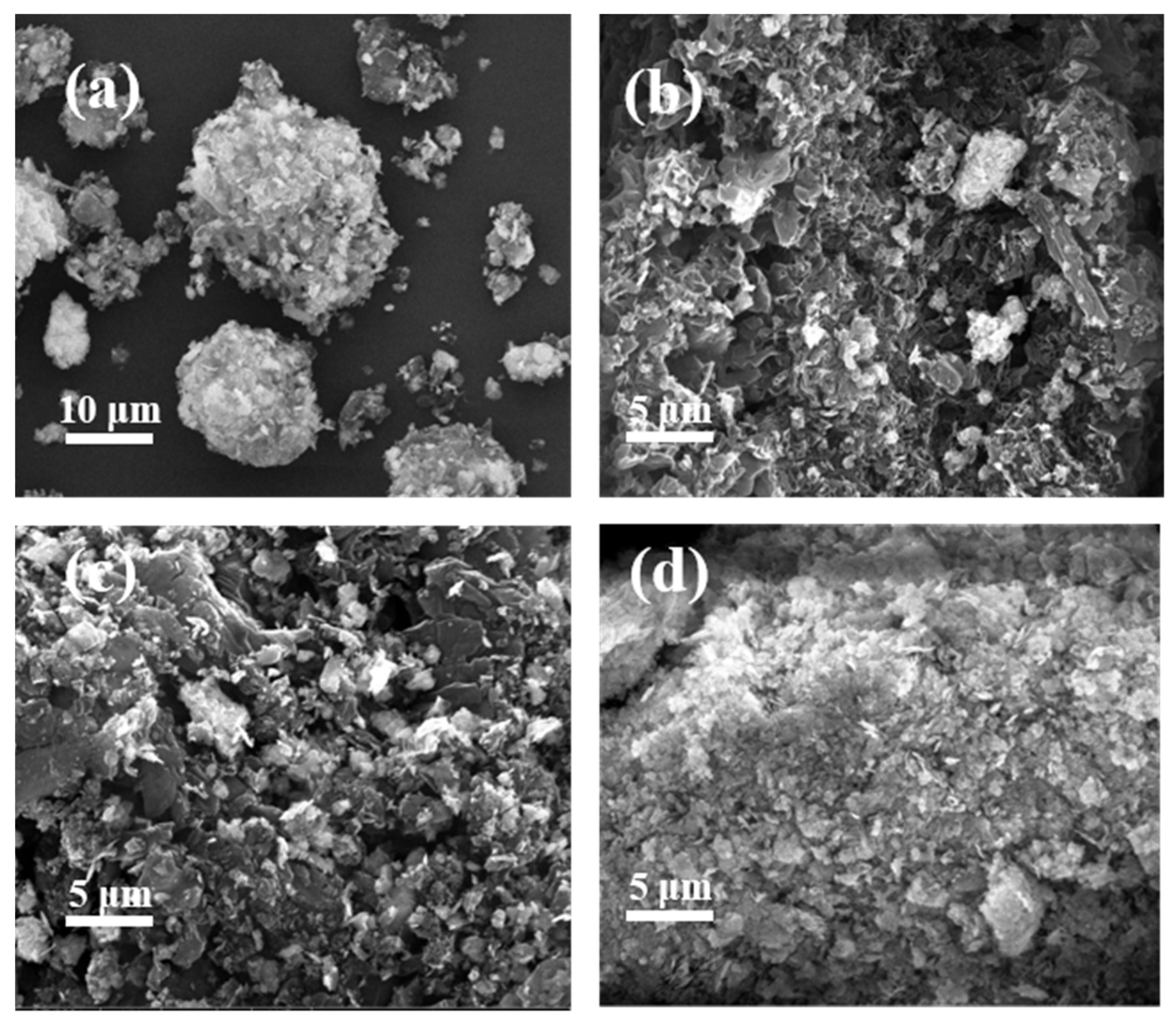
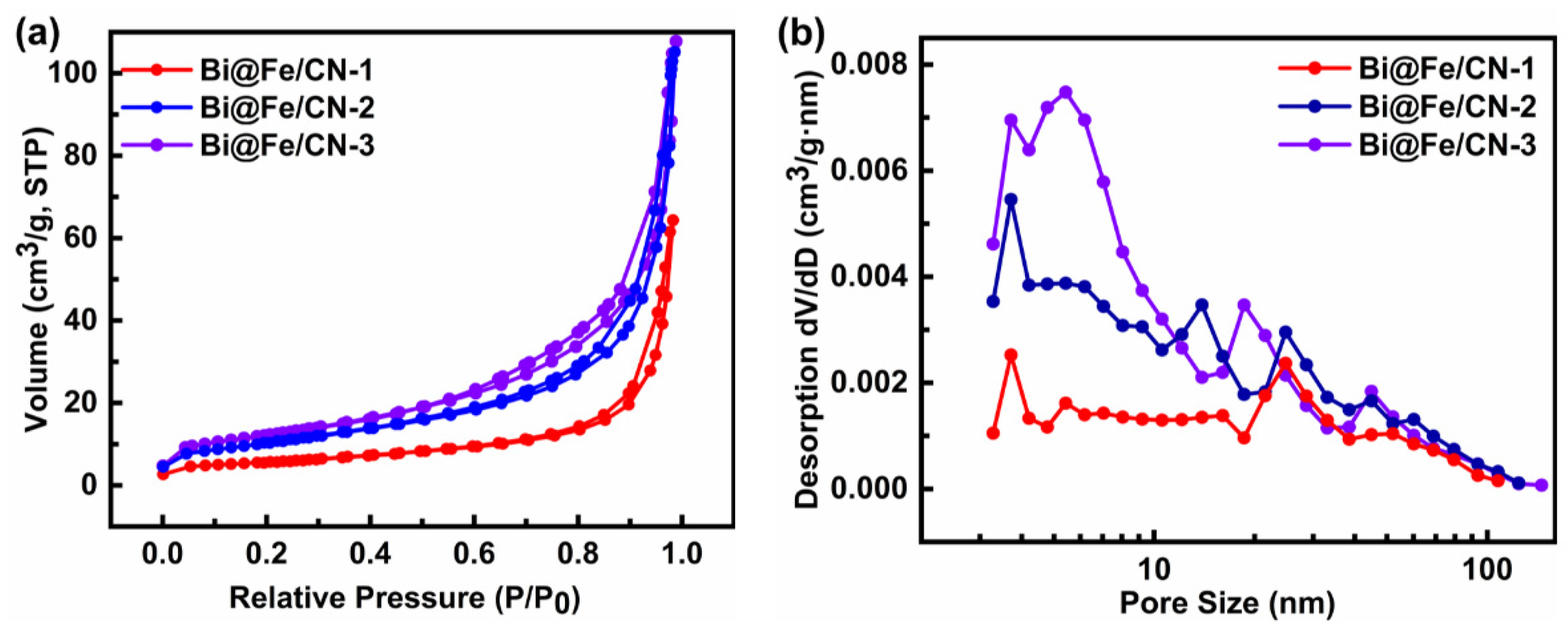
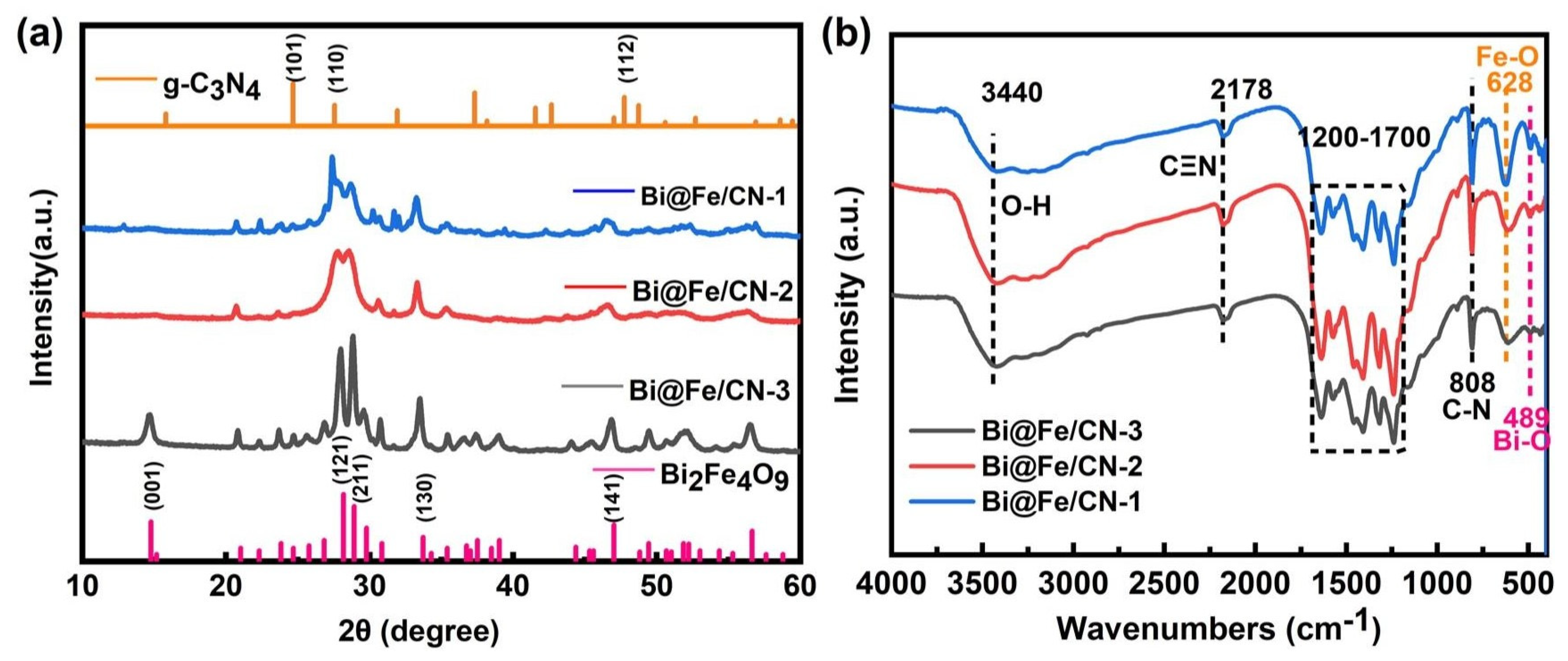
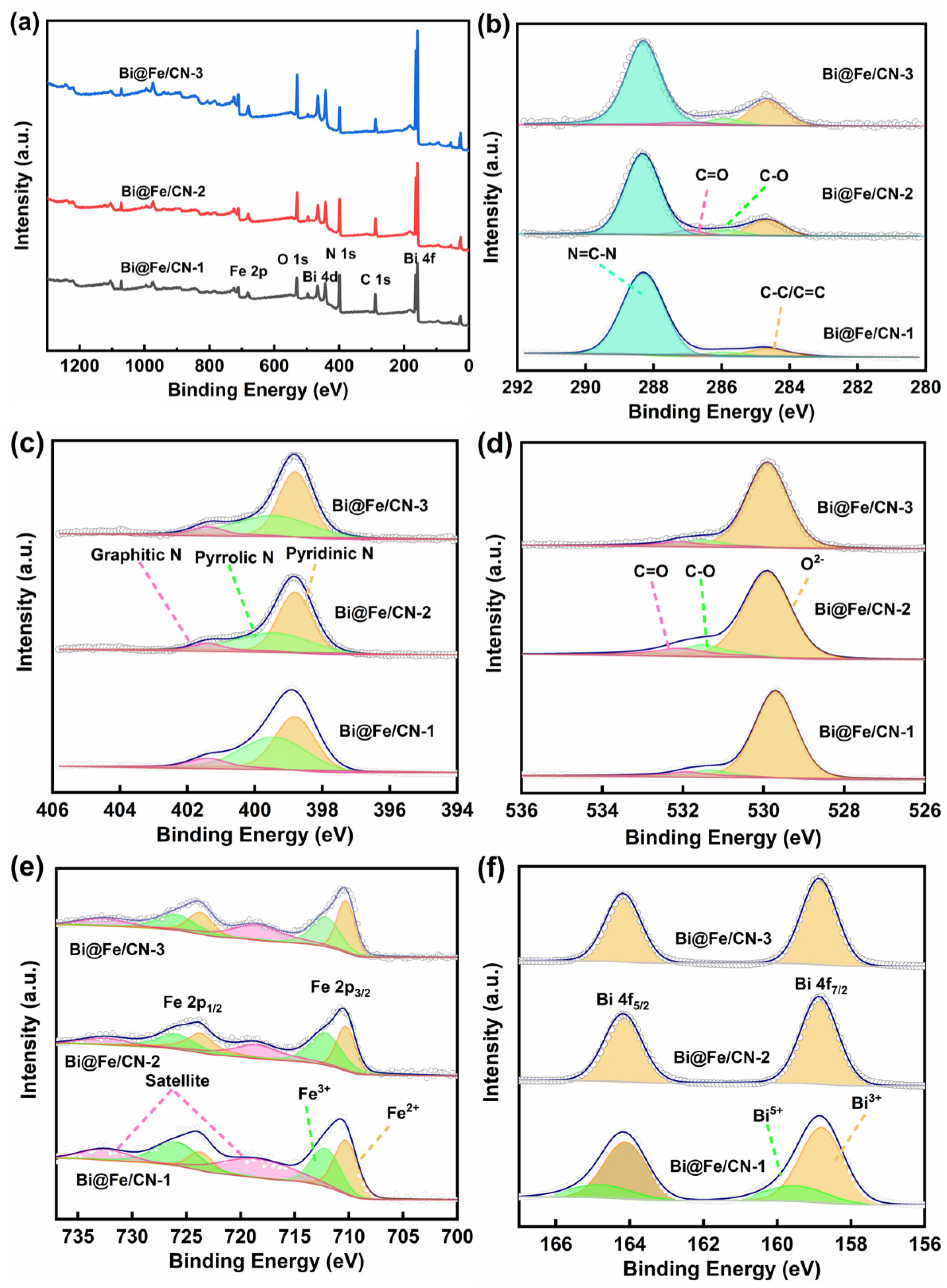
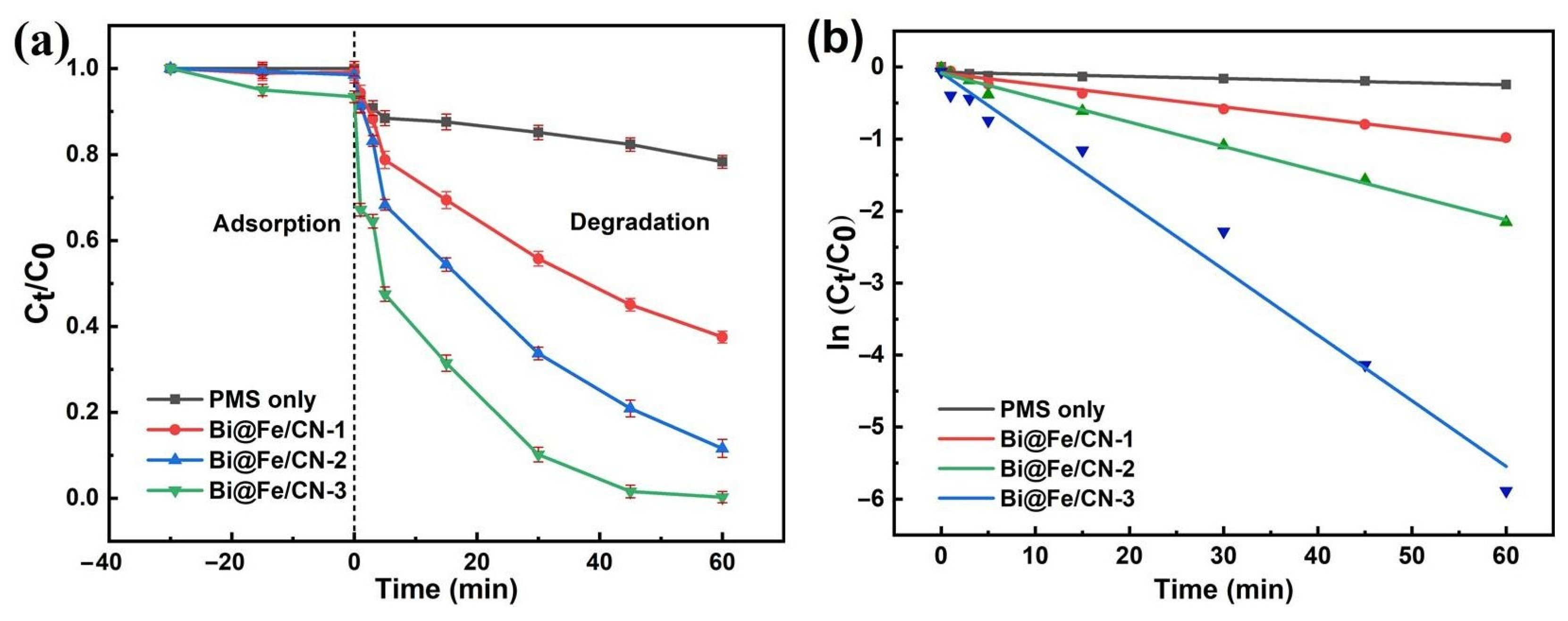

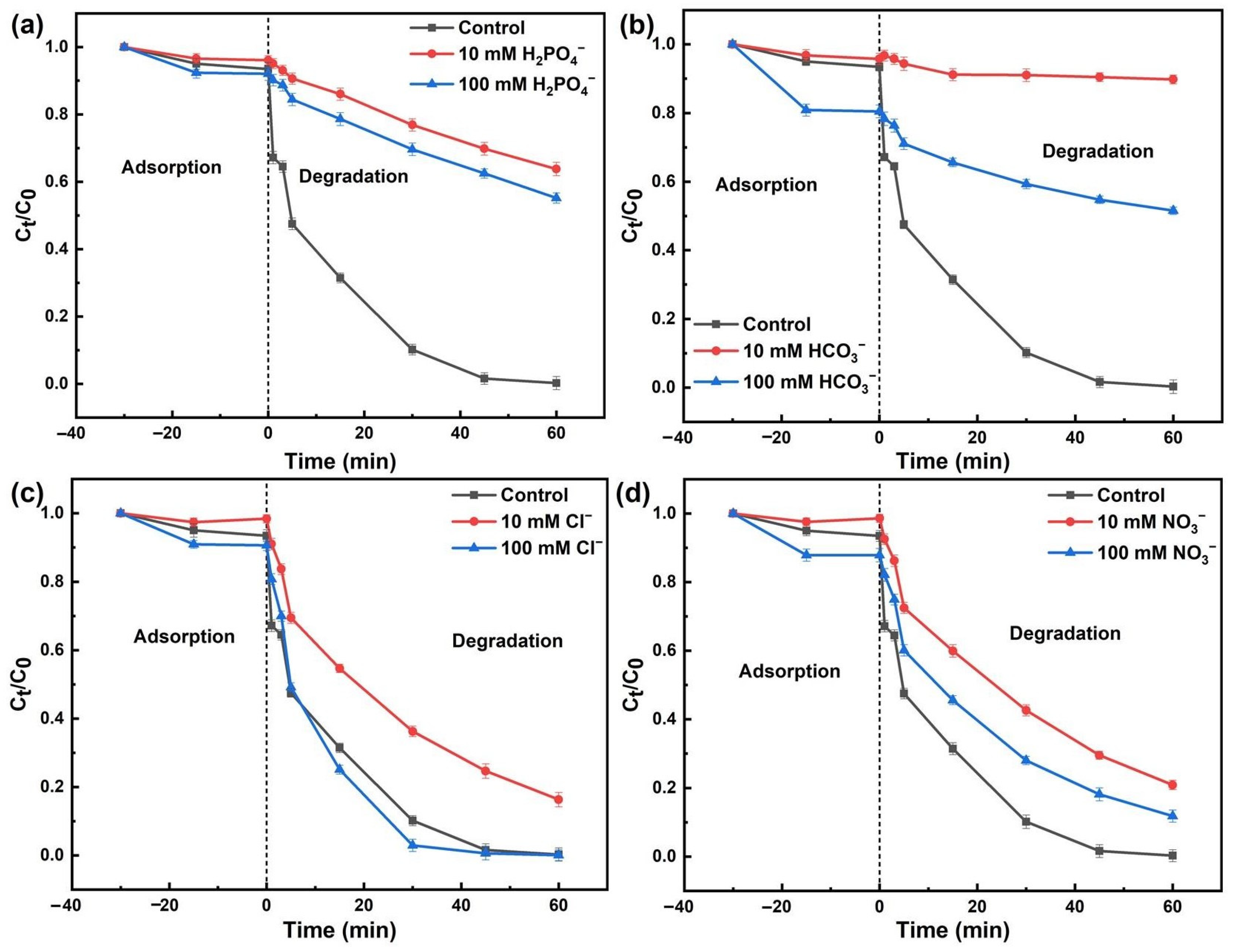
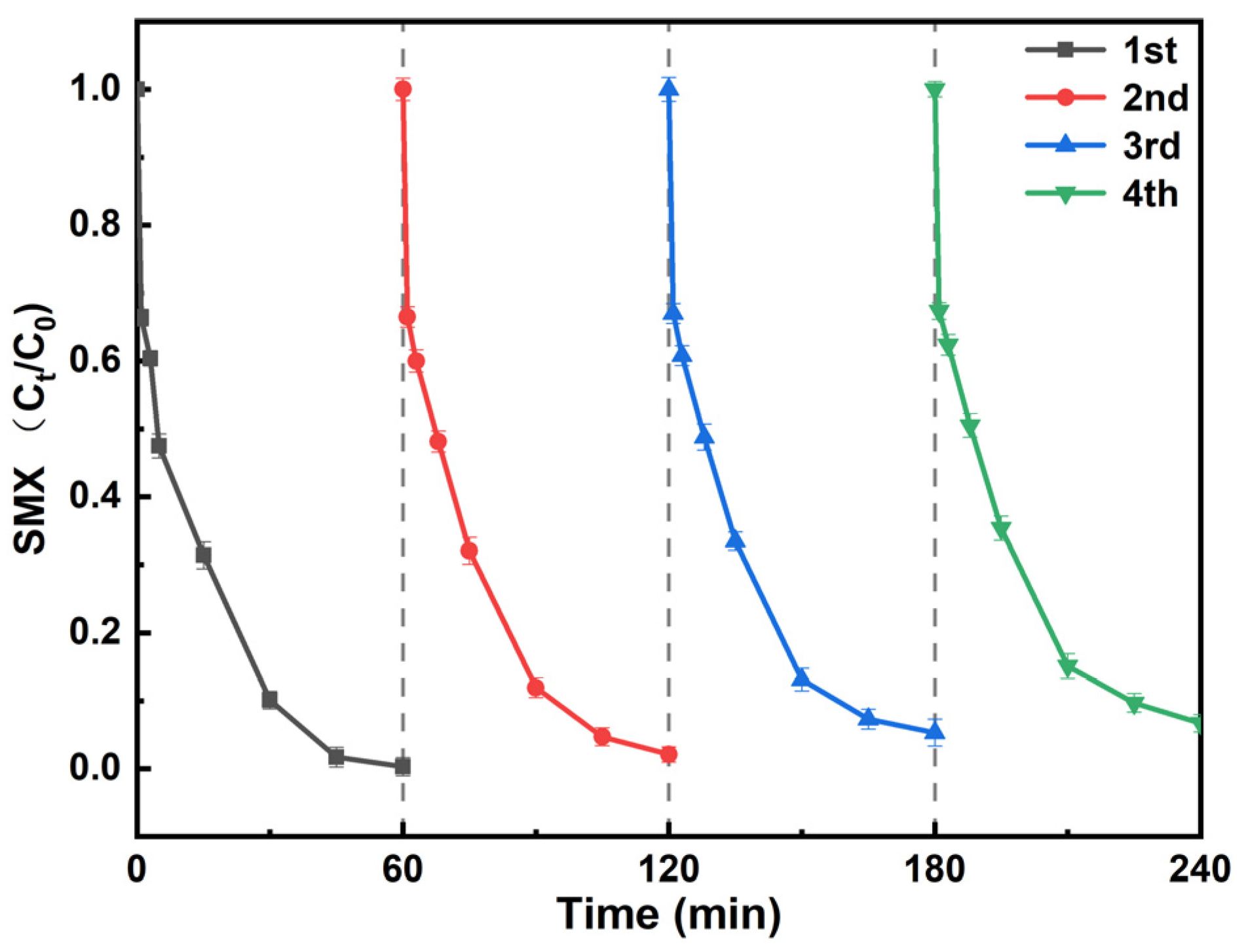
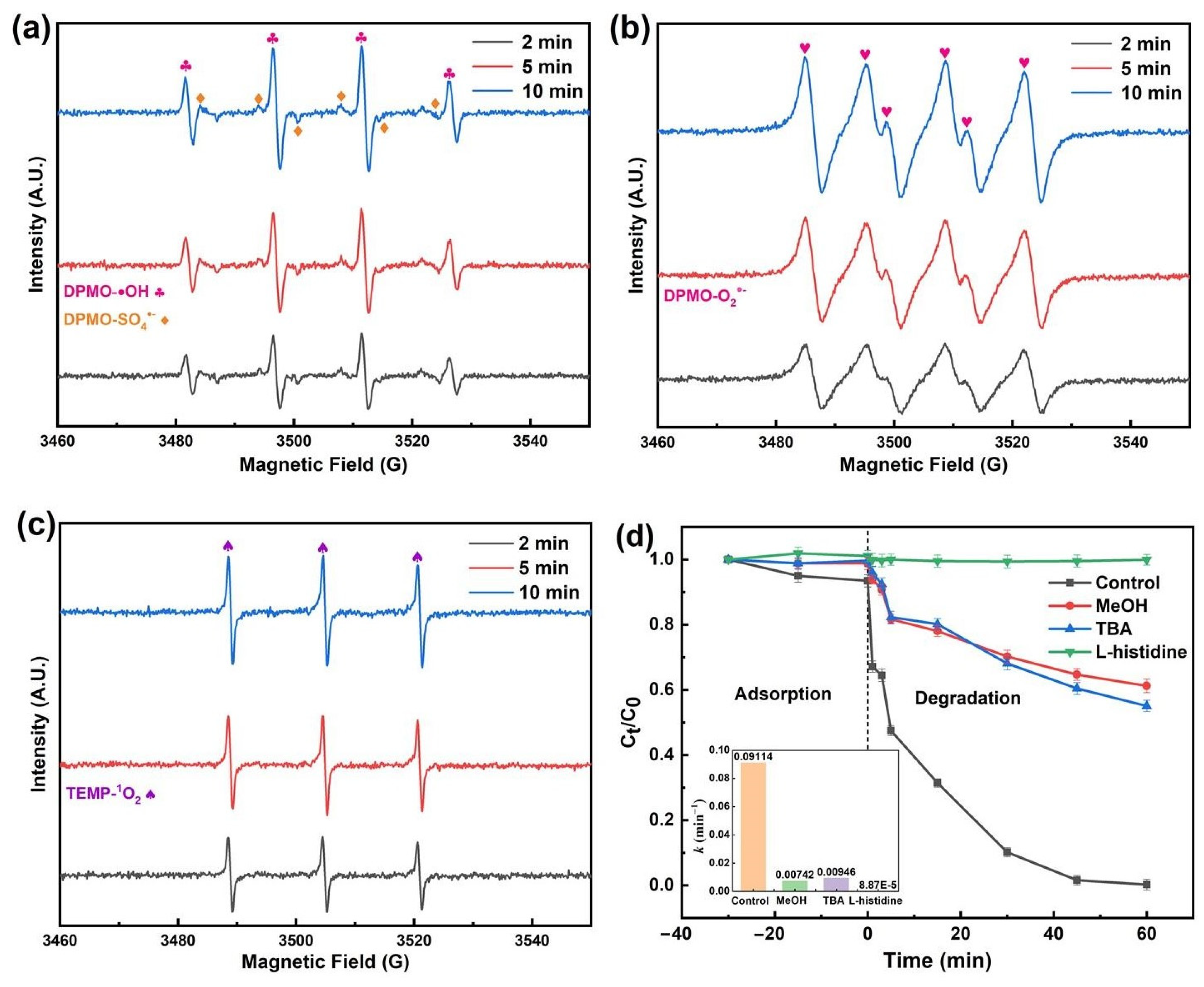


| Sample | Bi@Fe-1 | Bi@Fe-2 | Bi@Fe-3 |
|---|---|---|---|
| KOH concentration (mol) | 10 | 5 | 5 |
| Hydrothermal temperature (°C) | 120 | 120 | 160 |
| PMS Systems | [SMX] (mg·L−1) | [PMS] (mM) | [Catalyst] (g·L−1) | Time (min) | Degradation Rate * (%) | Reference |
|---|---|---|---|---|---|---|
| g-C3N4/PMS | 5.10 | 0.15 | 0.200 | 60 | 1.089 | [37] |
| FeOy/S-g-C3N4/PMS | 10.0 | 0.8 | 0.500 | 60 | 0.417 | [38] |
| FNCCN/PMS | 5.00 | 1.6 | 0.400 | 60 | 0.467 | [39] |
| Fe−Co−O−g-C3N4/PMS | 10.1 | 0.8 | 0.200 | 30 | 2.063 | [21] |
| Fe3O4/ß-FeOOH/PMS | 5.0 | 1.3 | 0.200 | 30 | 2.333 | [40] |
| Bi@Fe/CN-3/PMS | 15.0 | 0.6 | 0.100 | 45 | 2.432 | This work |
Disclaimer/Publisher’s Note: The statements, opinions and data contained in all publications are solely those of the individual author(s) and contributor(s) and not of MDPI and/or the editor(s). MDPI and/or the editor(s) disclaim responsibility for any injury to people or property resulting from any ideas, methods, instructions or products referred to in the content. |
© 2024 by the authors. Licensee MDPI, Basel, Switzerland. This article is an open access article distributed under the terms and conditions of the Creative Commons Attribution (CC BY) license (https://creativecommons.org/licenses/by/4.0/).
Share and Cite
Wang, Z.; Liang, L.; Li, N.; Wu, S.; Cheng, Z.; Yan, B.; Chen, G. Peroxymonosulfate Activation by Bi-Fe Oxide Co-Doped Graphitic Carbon Nitride for Degradation of Sulfamethoxazole: Performance and Mechanism. Appl. Sci. 2024, 14, 3181. https://doi.org/10.3390/app14083181
Wang Z, Liang L, Li N, Wu S, Cheng Z, Yan B, Chen G. Peroxymonosulfate Activation by Bi-Fe Oxide Co-Doped Graphitic Carbon Nitride for Degradation of Sulfamethoxazole: Performance and Mechanism. Applied Sciences. 2024; 14(8):3181. https://doi.org/10.3390/app14083181
Chicago/Turabian StyleWang, Zhili, Lan Liang, Ning Li, Shuang Wu, Zhanjun Cheng, Beibei Yan, and Guanyi Chen. 2024. "Peroxymonosulfate Activation by Bi-Fe Oxide Co-Doped Graphitic Carbon Nitride for Degradation of Sulfamethoxazole: Performance and Mechanism" Applied Sciences 14, no. 8: 3181. https://doi.org/10.3390/app14083181







